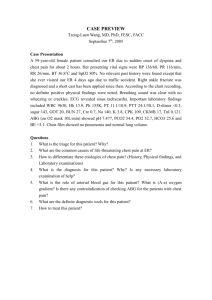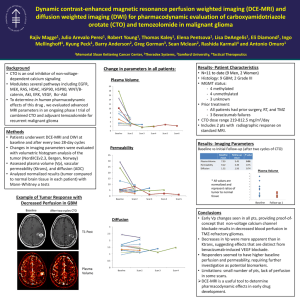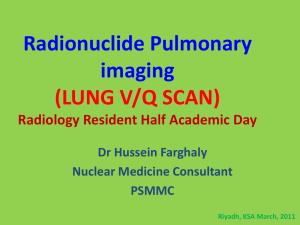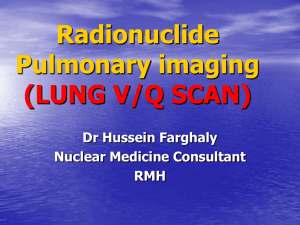Imaging Diagnosis of Suspected Pulmonary Embolism
advertisement
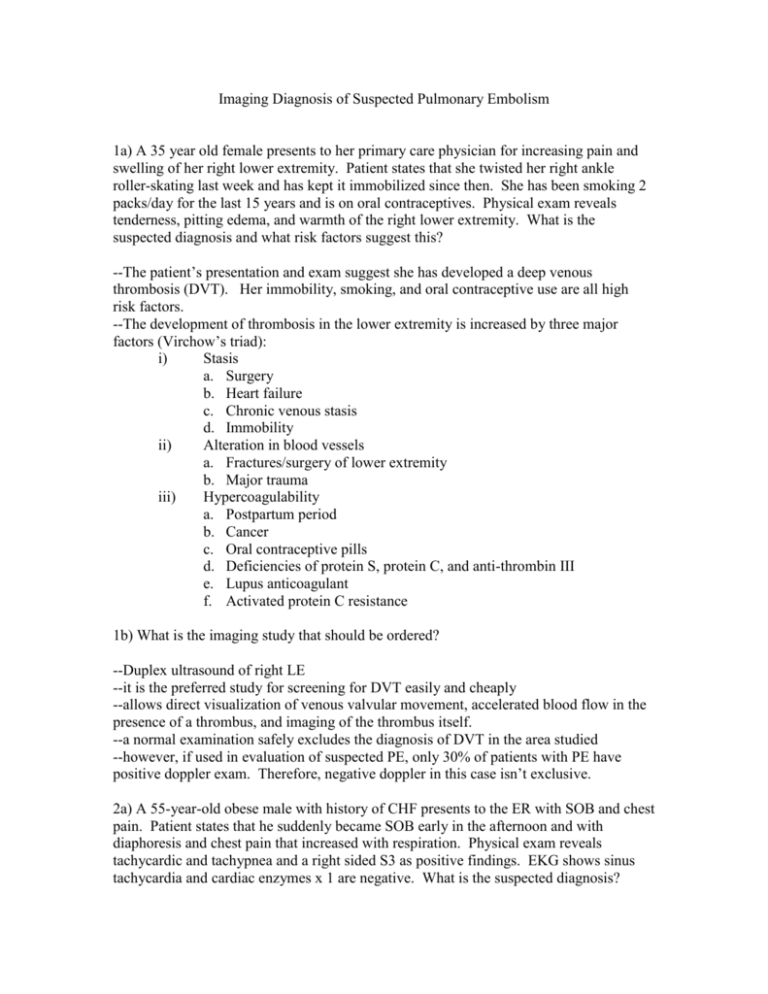
Imaging Diagnosis of Suspected Pulmonary Embolism 1a) A 35 year old female presents to her primary care physician for increasing pain and swelling of her right lower extremity. Patient states that she twisted her right ankle roller-skating last week and has kept it immobilized since then. She has been smoking 2 packs/day for the last 15 years and is on oral contraceptives. Physical exam reveals tenderness, pitting edema, and warmth of the right lower extremity. What is the suspected diagnosis and what risk factors suggest this? --The patient’s presentation and exam suggest she has developed a deep venous thrombosis (DVT). Her immobility, smoking, and oral contraceptive use are all high risk factors. --The development of thrombosis in the lower extremity is increased by three major factors (Virchow’s triad): i) Stasis a. Surgery b. Heart failure c. Chronic venous stasis d. Immobility ii) Alteration in blood vessels a. Fractures/surgery of lower extremity b. Major trauma iii) Hypercoagulability a. Postpartum period b. Cancer c. Oral contraceptive pills d. Deficiencies of protein S, protein C, and anti-thrombin III e. Lupus anticoagulant f. Activated protein C resistance 1b) What is the imaging study that should be ordered? --Duplex ultrasound of right LE --it is the preferred study for screening for DVT easily and cheaply --allows direct visualization of venous valvular movement, accelerated blood flow in the presence of a thrombus, and imaging of the thrombus itself. --a normal examination safely excludes the diagnosis of DVT in the area studied --however, if used in evaluation of suspected PE, only 30% of patients with PE have positive doppler exam. Therefore, negative doppler in this case isn’t exclusive. 2a) A 55-year-old obese male with history of CHF presents to the ER with SOB and chest pain. Patient states that he suddenly became SOB early in the afternoon and with diaphoresis and chest pain that increased with respiration. Physical exam reveals tachycardic and tachypnea and a right sided S3 as positive findings. EKG shows sinus tachycardia and cardiac enzymes x 1 are negative. What is the suspected diagnosis? --in a patient who presents with SOB and chest pain, the differential should include PE, pneumothroax, myocardial ischemia, pericarditis, asthma, and pneumonia. In this case, the presentation of pleurtic chest pain and sudden onset of dyspnea with risk factors of stasis (heart failure) suggest that PE should be high on differential. Cardiac enzymes are being followed for r/o MI protocol. 2b) A stat chest x-ray is ordered. What purpose does it serve in this case? --a chest x-ray is the first radiologic study in the evaluation of suspected PE. --it helps to exclude other possibilities, such as pneumonia, pneumothorax, esophageal perforation as etiologies. --although it is normal in most patients presenting with PE, there are certain findings suggestive of PE: i) classic triad of basal infiltrate, blunting of costophrenic angles, and elevated diaghragm. ii) increased lung lucency in area of embolus (“Westermark sign”) iii) wedge-shaped pleural based infiltrate (“Hampton’s hump”) 2c) Chest x-ray reveals small b\l pleural effusions. What is/are the next imaging studies to obtain? --Should get a ventilation/perfusion scan next and a Doppler of legs later to evaluate for possible source of clot. --perfusion scan involves injecting “small” number of isotope tagged microspheres intravenously. These microspheres “embolize” an insignificant number of capillaries and map perfusion. --ventilation scan produces images during inhalation of radioactive Xenon-133 --if a perfusion defect matches ventilation defect, it is interpreted as non-embolic airspace disease. --if a perfusion defect is not matched by a ventilation defect, it is likely due to embolism. --however, since the scan “sees” a absent perfusion but not the embolus, it isn’t completely specific. 2d) The V/Q scan shows intermediate probability. What does this mean? --Criteria for the size and number of unmatched perfusion defects create a “probability” factor in four classes: i) Normal scan—normal perfusion, normal ventilation: less than 1% chance of PE ii) Low probability—perfusion abnormalities from COPD or matched defects from pneumonia, masses or pleural effusions: less than 10-30% chance iii) High probability—unmatched segmental defects, probability 90% iv) Intermediate probability—matched defects (not from pleural effusions or pneumonia) or unmatched subsegmental defects: probability 10-90% --a normal scan basically excludes PE and indicates search for alternative explanations for the patient’s condition. --a High probability scan is usually sufficient to begin treatment. --a low probability scan can be used to withhold treatment, but if clinical signs are compelling then angiogram is indicated. --an intermediate probability scan provides no information and an angiogram is needed in further evaluation. 2e) Since our clinical suspicion is high for PE, what is our next step in radiologic assessment? --We should proceed to get a pulmonary angiogram --pulmonary arteriography is the gold standard and most accurate method of confirming the presence, size, and distribution of pulmonary emboli. --a series of radiographs outline areas of decreased perfusion and usually show filling defects or of decreased perfusion and usually show filling defects or the rounded trailing edge of impacted emboli. --a normal pulmonary angiogram excludes the diagnosis of PE --however, angiogram is an invasive procedure that has complications: i) during angiography, a catheter passes the right heart and may induce arrhythmia (more significant in left BBB cases) ii) x-ray contrast injection causes some increase in pulmonary resistance iii) in pulmonary hypertension, further increase may cause acute decompensation iv) rare: catheter may knot or perforate heart v) Morbidity 4% and mortality 0.3% 2f) What is the role of spiral CT in evaluation of PE? --a helical or spiral CT is best for detecting pulmonary emboli that involve central vessels. It visualizes clots in pulmonary artery and cut off of vessels --high sensitivity and specificity for central blood clots --provides alternate imaging modality in a patient with airway disease that would cause perfusion defects on V/Q scan. 2g) What is the sequence of evaluation for suspected PE? --Chest x-ray --Lung scan (perfusion defects) vs. Spiral CT (visualization of clots) --Doppler exam of legs (source of clots) --Pulmonary angiogram (gold standard)
